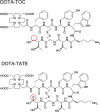Peptide Receptor Radionuclide Therapy: Looking Back, Looking Forward
- PMID: 32101125
- PMCID: PMC8493789
- DOI: 10.2174/1568026620666200226104652
Peptide Receptor Radionuclide Therapy: Looking Back, Looking Forward
Abstract
Peptide receptor radionuclide therapy (PRRT) is a highly effective anti-cancer treatment modality for patients with non-resectable, metastasized neuroendocrine tumors (NETs). During PRRT, specific receptors that are overexpressed on the cancer cells are targeted with a peptide labeled with a DNA-damaging radionuclide. Even though PRRT is a powerful treatment for metastasized NET patients, the majority still cannot be cured at this stage of the disease. Hence, many investigators focus on improving the therapeutic efficacy of this therapy. Improving PRRT can, for example, be achieved by using other radionuclides with different physical properties, by combining PRRT with radiosensitizing agents or by radiolabeling peptides with different characteristics. However, due to lack of extensive knowledge of radiobiological responses of cancer cells to PRRT, biological parameters that influence absorbed dose or that might even elicit insensitivity to therapy remain elusive and the context in which these improvements will be successful warrants further investigation. In this review, we will discuss the development of PRRT, its clinical merits in current treatment and future perspectives. We will highlight different radionuclides and their benefits and pitfalls, as well as different peptide-conjugates that hold these radionuclides. We will zoom in on the latest developments regarding combinatorial treatments and how investigators from different disciplines such as dosimetry and radiobiology are now joining forces to improve PRRT for NETs.
Keywords: Combination therapy; Neuroendocrine tumors (NET); Peptide receptor radionuclide therapy (PRRT); Radiobiology; Radiopharmaceuticals; Therapeutic effects.
Copyright© Bentham Science Publishers; For any queries, please email at epub@benthamscience.net.
Figures



Similar articles
-
Combination treatments to enhance peptide receptor radionuclide therapy of neuroendocrine tumours.Eur J Nucl Med Mol Imaging. 2020 Apr;47(4):907-921. doi: 10.1007/s00259-019-04499-x. Epub 2019 Sep 6. Eur J Nucl Med Mol Imaging. 2020. PMID: 31492995 Review.
-
Peptide receptor radionuclide therapy: an overview.Cancer Biother Radiopharm. 2015 Mar;30(2):47-71. doi: 10.1089/cbr.2014.1741. Epub 2015 Feb 24. Cancer Biother Radiopharm. 2015. PMID: 25710506 Review.
-
Update: improvement strategies for peptide receptor scintigraphy and radionuclide therapy.Cancer Biother Radiopharm. 2008 Apr;23(2):137-57. doi: 10.1089/cbr.2007.0435. Cancer Biother Radiopharm. 2008. PMID: 18454684 Review.
-
Peptide-based radiopharmaceuticals for targeted tumor therapy.Curr Med Chem. 2014;21(1):139-52. doi: 10.2174/09298673113209990219. Curr Med Chem. 2014. PMID: 23992337
-
Inter and intra-tumor somatostatin receptor 2 heterogeneity influences peptide receptor radionuclide therapy response.Theranostics. 2021 Jan 1;11(2):491-505. doi: 10.7150/thno.51215. eCollection 2021. Theranostics. 2021. PMID: 33391488 Free PMC article.
Cited by
-
Neoadjuvant therapy in pancreatic neuroendocrine neoplasms: A systematic review and meta-analysis.Front Oncol. 2022 Nov 24;12:981575. doi: 10.3389/fonc.2022.981575. eCollection 2022. Front Oncol. 2022. PMID: 36505835 Free PMC article.
-
Combination of [177Lu]Lu-DOTA-TATE Targeted Radionuclide Therapy and Photothermal Therapy as a Promising Approach for Cancer Treatment: In Vivo Studies in a Human Xenograft Mouse Model.Pharmaceutics. 2022 Jun 16;14(6):1284. doi: 10.3390/pharmaceutics14061284. Pharmaceutics. 2022. PMID: 35745856 Free PMC article.
-
Combination Systemic Therapies in Advanced Well-Differentiated Gastroenteropancreatic Neuroendocrine Tumors (GEP-NETs): A Comprehensive Review of Clinical Trials and Prospective Studies.Biology (Basel). 2023 Jul 30;12(8):1069. doi: 10.3390/biology12081069. Biology (Basel). 2023. PMID: 37626955 Free PMC article. Review.
-
In Vivo Efficacy Testing of Peptide Receptor Radionuclide Therapy Radiosensitization Using Olaparib.Cancers (Basel). 2023 Feb 1;15(3):915. doi: 10.3390/cancers15030915. Cancers (Basel). 2023. PMID: 36765883 Free PMC article.
-
DNA Damage-Inducing Anticancer Therapies: From Global to Precision Damage.Cancers (Basel). 2020 Jul 28;12(8):2098. doi: 10.3390/cancers12082098. Cancers (Basel). 2020. PMID: 32731592 Free PMC article. Review.
References
-
- Hofving T., Arvidsson Y., Almobarak B., Inge L., Pfragner R., Persson M., Stenman G., Kristiansson E., Johanson V., Nilsson O. The neuroendocrine phenotype, genomic profile and therapeutic sensitivity of GEPNET cell lines. Endocr. Relat. Cancer. 2018;25(3):367–380. doi: 10.1530/ERC-17-0445. - DOI - PMC - PubMed
Publication types
MeSH terms
Substances
LinkOut - more resources
Full Text Sources
Other Literature Sources
